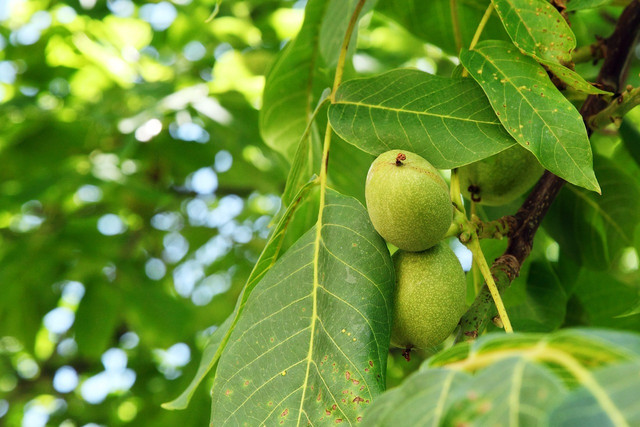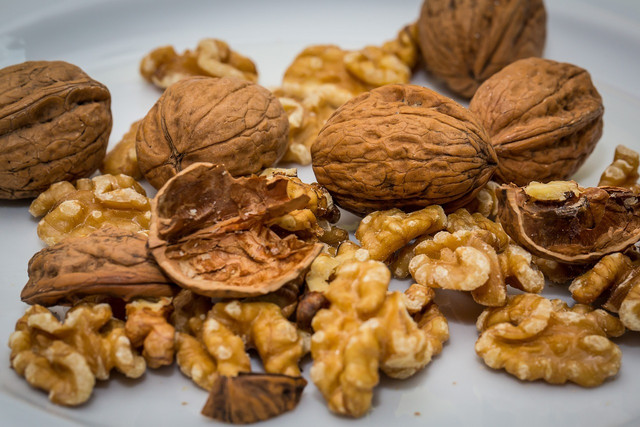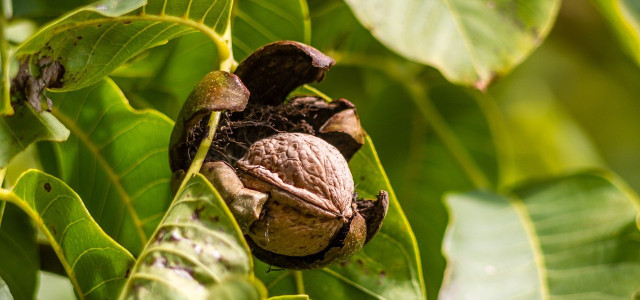Though they are so easily accessible at the supermarket, how do walnuts grow? Read to learn about the environmental impact of walnut production!
Though typically categorized as a nut, the walnut is actually a single-seed stone fruit. It belongs to the same family of fruits as cherries, peaches, apricots, lychees and mangoes. Walnuts are packed with vitamins, minerals and healthy fats, including omega-3 polyunsaturated fat.
The two most popular walnuts are the English or Persian walnut and the black walnut, both of which are grown for their seeds.
But, more importantly: How do walnuts grow? Read on to find out.
Where and How do Walnuts Grow?

(Foto: CC0 / Pixabay / PublicDomainPictures)
The English walnut is native to Iran, while the black walnut is native to eastern North America. Black walnuts are not often commercially farmed because they have hard shells which are difficult to crack open. Still, black walnuts can be found throughout the US and Canada as scattered individual trees or in small groves of mixed trees.
English walnut tree orchards are most common in the US, China, Iran and Turkey. Furthermore, many commercial farms grow hybrids.
Walnuts are surrounded by hard, wrinkly or ridged shells, inside which are green husks that contain the edible portion of the fruits themselves. While you may have cracked walnuts open from their shells, it’s less likely you’ve seen the husk up close. When walnuts ripen in the fall, the husks open wide and shrivel up. That’s when walnuts, encased in their brown shells, fall from the tree.
Walnuts are typically harvested between August and November when their green hulls dry out, and the shelled walnut can be removed. First, workers sweep the ground for any fallen walnuts. Then, machines shake each tree to loosen the fruit from their branches. Next, All the fallen walnuts are then taken for cleaning and processing. If needed, the outer green husk is removed by a huller. Shelled walnuts are dried to preserve them for as long as possible. Some are sold in-shell, while others are sent to a shelling center where they are cracked open, sorted and packaged.
Is Walnut Farming Sustainable?
Although walnut harvesting involves a lot of heavy machinery — and thus considerable energy — walnut production is relatively sustainable as long as it’s organic. Organic walnut production does not pollute or damage the air, soil, water or animals. In fact, research shows that, compared to almonds, brazil nuts, cashews, chestnuts, peanuts, hazelnuts, pistachios, sesame seeds and sunflower seeds, walnuts are one of the most sustainable “nuts” when considering carbon footprint, land use and water use.
Look for walnuts that are certified organic and fair trade to ensure you’re purchasing products with the smallest social and environmental impact.
Cooking and Baking with Walnuts



(Foto: CC0 / Pixabay / maxmann)
Now that we’ve answered the question “How do walnuts grow?” we can move on to the fun part.
There are many ways to eat walnuts. They make delicious snacks, raw or roasted, and they go well in oatmeal, pies, granola and pasta. We recommend making homemade candied walnuts and pickled walnuts.
For vegans and people with lactose intolerance, walnut milk is delicious and easy to make yourself. You can also make this lentil and walnut roast for your next Sunday dinner, or over the holidays. In baking, walnuts can even be used to make low-carb flour for cakes, pies, cookies and more!
Read more:
- How Are Pistachios Grown & Are They Sustainable?
- A Deep Dive Into Sugar: Sustainability and Health Impact
- 11 Superfoods for Energy, but Also Sustainability
Do you like this post?






